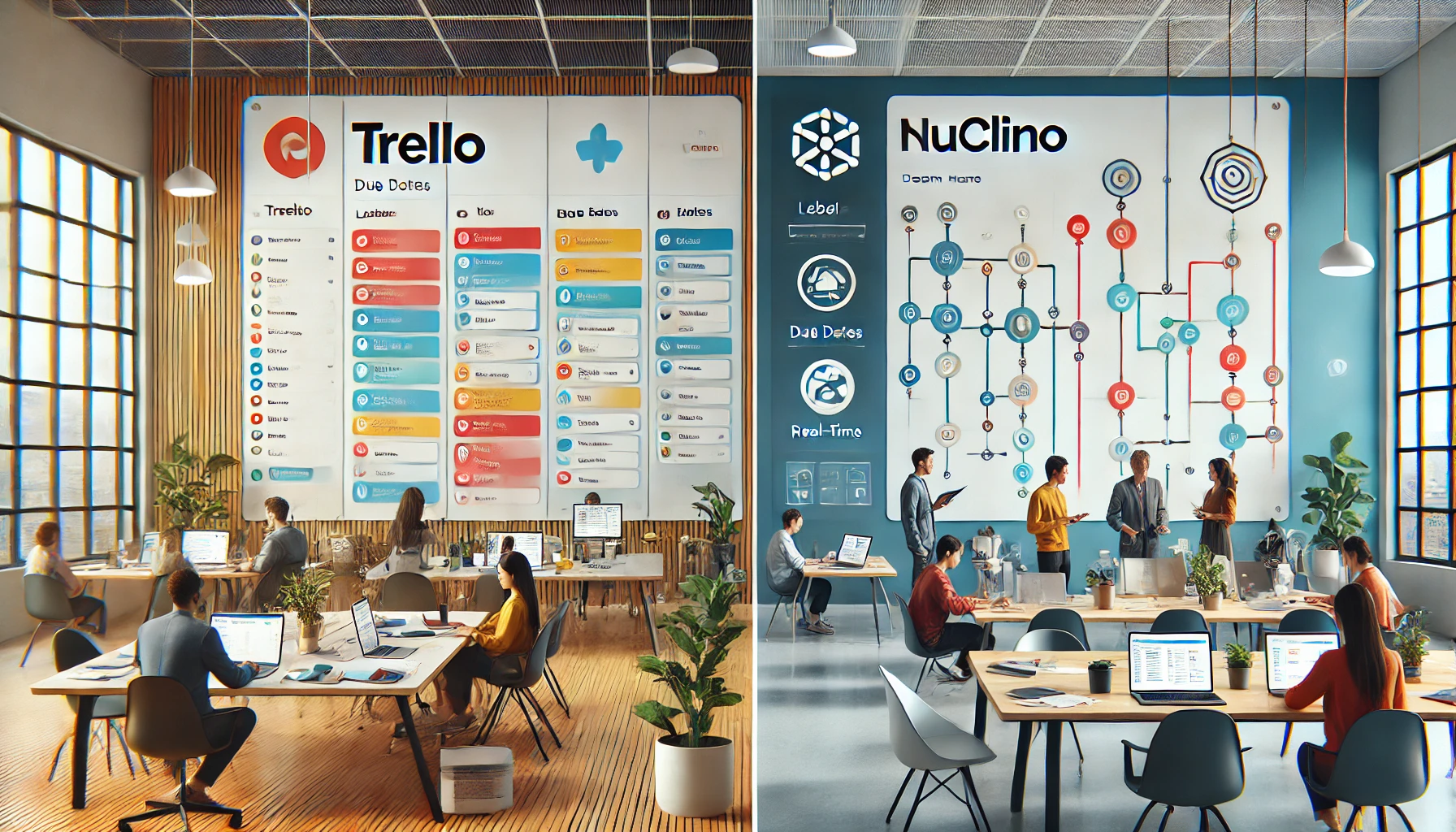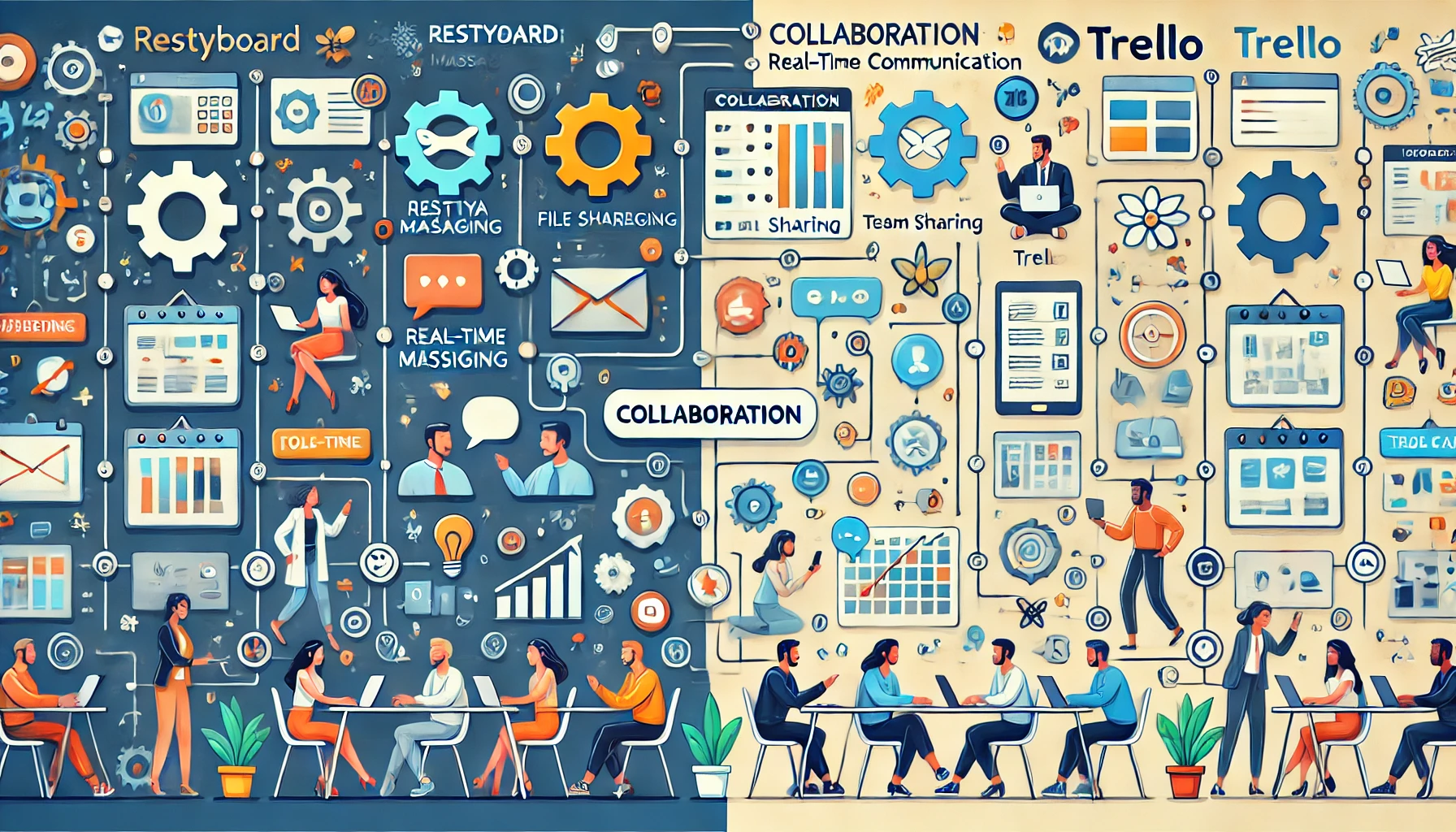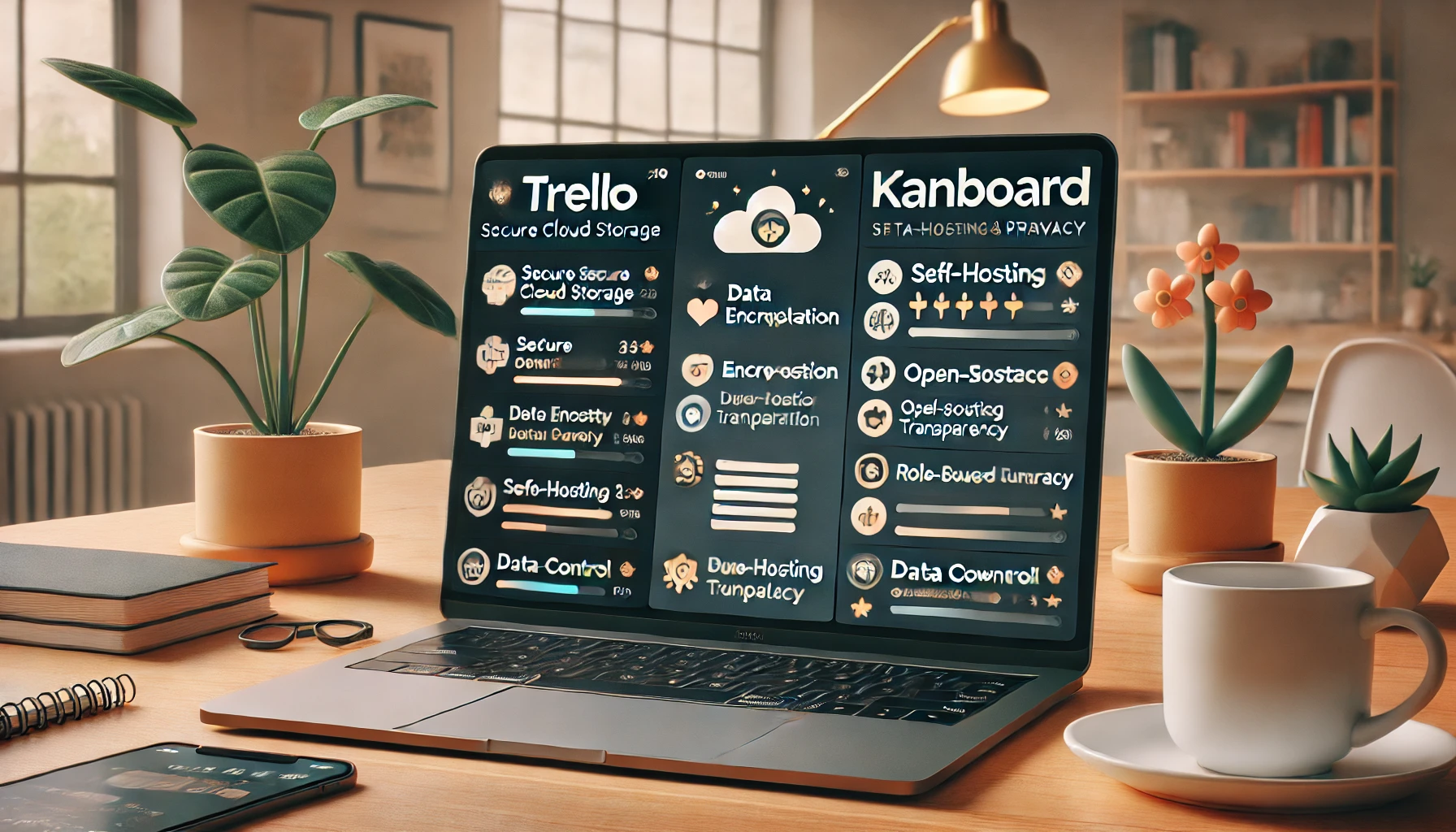Finding the perfect tool for teamwork and collaboration is a journey. Trello and Nuclino are two heavyweights in this arena, both geared to make teamwork easier, more visual, and a whole lot less chaotic. But which one fits your team’s needs best?
In this post, we’ll dive deep into the key features, pros, and cons of Trello and Nuclino, so you can decide which of these collaboration tools deserves a spot in your workflow. Whether you’re looking for streamlined project management or a powerful knowledge-sharing platform, we’ve got you covered.
What Is Trello? A Quick Overview
Trello is a project management and task organization tool that brings the power of the Kanban method to your team’s fingertips. Owned by Atlassian, it’s well-known for its card-and-board setup that allows users to organize projects, set deadlines, track progress, and even automate some repetitive tasks.
The “board” structure is key to Trello’s appeal. Each project gets its own board, where tasks are added as “cards” that you can drag and drop into different “lists” as work progresses. Think of it as a digital version of the sticky note method: clear, customizable, and accessible. Trello’s visual approach makes it an ideal fit for teams that work well with a straightforward, process-oriented view.
But don’t let its simplicity fool you—Trello has an array of power-ups (or integrations) that add functionality for those who need it, from calendar syncing to automation tools.
Popular Trello Features:
- Boards, Lists, and Cards: Organize tasks in a way that feels like organizing ideas on a whiteboard.
- Butler Automation: Use Trello’s automation bot to handle repetitive tasks.
- Power-ups: Integrations with tools like Slack, Google Drive, and Confluence.
- Templates: Pre-made board setups for various use cases, from Agile workflows to editorial calendars.
For teams with structured workflows that thrive on visual planning, Trello’s Kanban board style can be a game-changer.
What Is Nuclino? An Introduction to the Knowledge Hub
Nuclino, on the other hand, offers a more nuanced approach. It’s designed to be an all-in-one workspace where teams can not only manage projects but also store, organize, and share knowledge. Imagine if a task manager and a wiki had a brainy, minimalist child—that’s Nuclino.
Unlike Trello’s straightforward card-and-board approach, Nuclino uses a more flexible “graph” structure. This layout allows information to be stored and connected in a web-like, interconnected way, which makes it particularly suited to knowledge-heavy environments. Teams can create individual items (similar to Trello cards), organize them into boards, lists, or mind maps, and link them to related information.
Standout Features in Nuclino:
- Graph View: Allows you to see interconnected items and create visual knowledge maps.
- Collaborative Editing: Real-time editing, comments, and version history make it easy for teams to collaborate.
- Simple Interface: A minimalist design that helps keep your focus on the work, not the app.
- Integrations: Supports a range of integrations, including Slack and Google Drive.
- Knowledge Base: Great for building out structured, easily navigable knowledge bases.
Nuclino shines when it comes to knowledge management. If your team needs a space for both planning and reference material, Nuclino’s combination of task and information management might be just what you need.
Key Differences: Trello vs. Nuclino
The big difference between Trello and Nuclino lies in their design philosophy and core purpose. Trello is, at heart, a project management tool. Its board system and card-based tasks cater well to linear workflows where tasks move from one stage to another. Nuclino, on the other hand, is a knowledge-centric tool that emphasizes interconnectivity and collaboration in a more exploratory layout.
With Trello, teams get a straightforward tool for tracking and completing projects. Nuclino offers a space for teams to dig deeper into information, create links between knowledge, and even manage projects in a way that encourages collaboration and reference-building.
| Feature | Trello | Nuclino |
|---|---|---|
| Primary Use | Project management | Knowledge management and collaboration |
| Visual Layout | Kanban-style boards | Graph, list, and board views |
| Collaborative Editing | Limited | Full real-time editing |
| Integrations | Extensive (Power-Ups) | Moderate, focused on productivity |
| Automation | Butler Automation | Minimal automation options |
| Flexibility | Highly customizable with Power-ups | Structured, focus on knowledge organization |
In a nutshell, Trello is ideal for teams needing a flexible, visual way to manage tasks. Nuclino appeals to those who need a structured, interconnected approach to team knowledge and collaboration.
Usability: Which Tool Has a Smoother Learning Curve?
When it comes to usability, both Trello and Nuclino cater to different types of users. Trello is famously intuitive. With its drag-and-drop functionality and simple board setup, even beginners can quickly get comfortable navigating through the app. Its straightforward design and limited (but sufficient) feature set make it highly user-friendly.
Nuclino, though equally simple in its layout, has a bit of a learning curve—mainly due to its graph view and interconnected structure. While this structure is highly beneficial for knowledge-heavy projects, it can feel overwhelming if you’re used to linear workflows. The graph view is ideal for those who need to understand how different pieces of information relate to one another, but it may take some getting used to.
For most users:
- Trello has a quicker setup and a very low barrier to entry. It’s ideal for teams or individuals needing an intuitive platform with minimal fuss.
- Nuclino might require a bit more onboarding, especially if you plan to use it for knowledge management, but once mastered, it can make organizing complex information a breeze.
Pro Tip: If you’re considering Nuclino, set aside some time for a team demo. Nuclino’s user interface is designed to be minimal, but a short onboarding session can help maximize its value quickly.
Integration Options: How Well Do They Play with Other Tools?
Integrations are essential for any team working with multiple tools. Here, Trello has a significant advantage. Known for its extensive integration library, Trello supports a variety of add-ons, known as Power-Ups, that help connect it with practically any app in a typical team’s toolkit. From Google Workspace to Slack and even other Atlassian products like Confluence, Trello makes it easy to sync with your existing setup.
Nuclino, while not as broad in its integration offerings, is more focused. It integrates with essential tools, including Slack and Google Drive, but it doesn’t have the vast array of options that Trello offers. The integrations Nuclino does support are designed to supplement its knowledge-based approach, so they might lack some of the more specific task management integrations Trello offers.
Collaboration: Real-Time Interaction and Team Communication
When it comes to real-time collaboration, Nuclino takes the lead. Built for teamwork, Nuclino offers real-time editing that’s reminiscent of Google Docs, where team members can make edits simultaneously. This feature works well for teams that need to create, edit, and manage content together. Each page in Nuclino has a comment section where team members can discuss ideas, ask questions, or provide feedback, creating a live conversation around your work. It even supports @mentions, so you can tag specific team members when their input is needed.
Trello, while not as collaborative in real-time, still provides essential tools for team coordination. It doesn’t support live editing on a card’s text or descriptions in the way that Nuclino does, but you can leave comments, tag teammates, and receive notifications when someone interacts with a task. Trello’s notifications are reliable and customizable, keeping users informed on project updates, card movements, and task assignments.
If seamless, real-time collaboration is a must for your team, Nuclino might be the better choice here. Trello still allows for collaboration but in a more sequential, rather than simultaneous, fashion.
Customization and Flexibility: Making the Tool Your Own
Customization is where Trello shines. Known for its flexibility, Trello offers a wide range of customization options that make it easy for teams to adapt boards, lists, and cards to fit unique workflows. You can add Power-Ups to expand functionality, create templates for different project types, and color-code cards for prioritization. Plus, Trello’s automation feature (Butler) lets users set up automated actions based on specific triggers. For example, you could automate moving a card to a “Done” list once the due date is met, or create custom buttons that streamline repetitive tasks.
Nuclino, in contrast, is simpler and more structured, focusing on information rather than visual customization. While it’s designed for ease of use, it doesn’t offer as much flexibility in terms of customization. You can organize information using boards, lists, or graphs, but there’s no equivalent to Trello’s Butler automation or color-coded labels. This makes Nuclino a bit more rigid—ideal if you prefer a cleaner, straightforward approach, but limiting if your team values flexibility.
Pro Tip: If customization and workflow automation are priorities, Trello’s flexibility is tough to beat.
Pricing: Which Tool Gives You More Value?
Budget matters, especially if you’re considering these tools for a larger team. Here’s how Trello and Nuclino stack up in terms of pricing:
Trello’s Pricing Plans:
- Free – Basic features with unlimited cards, 10 boards per workspace, and basic integrations.
- Standard – $5 per user/month: Adds unlimited boards, advanced checklists, and custom fields.
- Premium – $10 per user/month: Includes timeline and calendar views, advanced automation, and more.
- Enterprise – Custom pricing: Designed for larger organizations needing admin controls and security features.
Nuclino’s Pricing Plans:
- Free – Limited to 50 items, with a max of 2 GB of storage.
- Standard – $5 per user/month: Removes item limits, adds priority support, and expands integrations.
- Premium – $10 per user/month: Includes additional storage, advanced access controls, and more customization options.
While both platforms offer free versions, Trello’s free plan gives users more flexibility with unlimited cards and access to many Power-Ups. For small teams or individuals, Trello’s free plan can be more than enough. However, if you need advanced features like calendar views and automation, you’ll likely need to upgrade to a paid plan.
Nuclino’s free plan is more limited in scope, so if you’re planning on using it extensively, a paid plan is almost necessary. However, for those in need of a dedicated knowledge base, Nuclino’s Standard plan is a budget-friendly option with its powerful real-time collaboration features.
Security and Privacy: How Safe Is Your Data?
Both Trello and Nuclino prioritize user data privacy and security, but they approach it differently.
Trello, as part of the Atlassian ecosystem, benefits from Atlassian’s established security protocols. With options for two-factor authentication, data encryption, and compliance with industry standards (such as SOC2 and ISO/IEC 27001), Trello provides robust security for businesses and individuals alike. Its Enterprise plan also offers more in-depth security measures, like IP allowlisting and advanced administrative controls, making it a good fit for companies with strict security needs.
Nuclino, while smaller in scope, also takes privacy seriously. It offers encryption for data both in transit and at rest, ensuring that user data is protected. It’s also GDPR-compliant, which is a must for teams handling user data within the EU. That said, Nuclino doesn’t offer the same depth of security features as Trello’s Enterprise plan, so larger companies with stringent data requirements might find it less suitable.
For high-security environments, Trello may have the edge due to its compliance features and expanded controls at the enterprise level.
Pros and Cons Recap: Trello vs. Nuclino
Here’s a quick recap to help you see which tool might suit your needs better:
Trello
Pros:
- Highly visual, intuitive Kanban boards
- Extensive customization and automation
- Broad range of integrations with third-party tools
- Suitable for task and project management
Cons:
- Limited real-time collaboration
- Can be overwhelming with Power-Ups for new users
Nuclino
Pros:
- Ideal for knowledge sharing and real-time collaboration
- Clean, minimalist interface with a structured, interconnected layout
- Graph view offers unique ways to visualize information
Cons:
- Limited customization and fewer automation options
- Less flexible integration options
- More limited free plan
So, Which Tool is Right for You?
Ultimately, the choice between Trello and Nuclino depends on your team’s workflow needs. If your team values visual task tracking and the ability to customize workflows with automations, Trello is a strong choice. Its Kanban-style boards are highly adaptable, making it an ideal choice for teams focused on project management.
On the other hand, if your work requires a structured knowledge base with collaborative editing and an interconnected layout, Nuclino could be the better option. Its clean, graph-based interface and real-time editing capabilities make it ideal for teams that need to manage shared knowledge or collaborate on content.
If you’re still unsure, both tools offer free trials or free versions, so you can test them out and see which fits your team’s rhythm better. Whether you need a digital whiteboard or a knowledge-sharing platform, Trello and Nuclino both bring unique features to the table, helping you collaborate more efficiently in their own ways.
For more insights and user feedback on both tools, check out additional reviews and comparison guides from trusted sources like PCMag, Capterra, or G2.
Happy collaborating!




